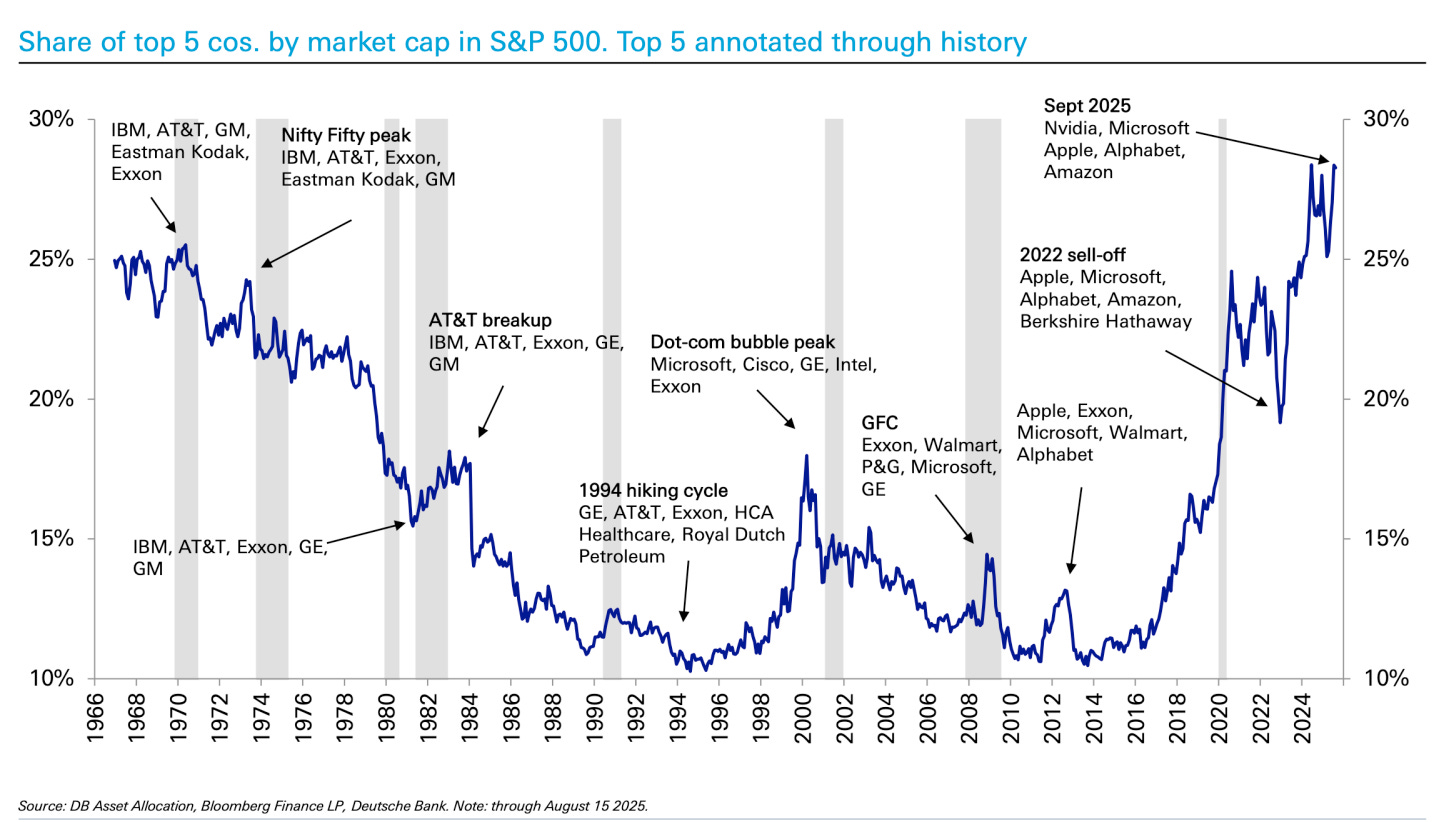🌀🗞 The FLUX Review, Ep. 205
September 4th, 2025

Episode 205 — September 4th, 2025 — Available at read.fluxcollective.org/p/205
Contributors to this issue: Neel Mehta, Boris Smus, Erika Rice Scherpelz, Justin Quimby, MK
Additional insights from: Ade Oshineye, Alex Komoroske, Anthea Roberts, Ben Mathes, Chris Butler, Dart Lindsley, Dimitri Glazkov, Jasen Robillard, Jon Lebensold, Julka Almquist, Kamran Hakiman, Lisie Lillianfeld, Melanie Kahl, Robinson Eaton, Samuel Arbesman, Scott Schaffter, Spencer Pitman, Wesley Beary
We’re a ragtag band of systems thinkers who have been dedicating our early mornings to finding new lenses to help you make sense of the complex world we live in. This newsletter is a collection of patterns we’ve noticed in recent weeks.
“I have yet to see any problem, however complicated, which, when looked at in the right way, did not become still more complicated.”
— Poul Anderson
1️⃣🏋️ Just one exception
A customer asks for a small variation of an existing feature. No one can agree on whether or not to do it. The discussion centers around the tradeoffs: “It’s just one exception.”
For the sales team, this phrase is comforting. A small number of exceptions means the extra work is manageable. Each exception creates another cycle of review, approval, and explanation. In a world of manual work, fewer is better. And for sales, “one” often means “one and done.”
For engineering, the phrase is ominous. “One” is the most expensive number: it demands all the design, testing, and maintenance of a feature without the payoff of reuse. Until more customers adopt it, there’s no way to spread out the fixed cost. In a world of automation, volume is what makes features economical.
We can look at exceptions as potential investments in a company’s feature portfolio. We need to step back from the cost to individual teams and instead look at the overall cost. Manual work scales linearly. Each new exception adds weight in a straightforward, cumulative way. Automated work curves, such as those found in engineering and product development, front-load the cost. The first exception is the heavy lift, and every additional use reduces the relative burden by amortizing that fixed cost.
Then understand how it fits into the bigger picture: given everything going on, is this investment worth making at this cost? Seeing exceptions through this lens turns them from isolated annoyances into strategic bets about where the cost will land and how it will scale.
Once the investment decision is clear, each group can adapt its approach. If something is a true one-off, engineering can build lighter, narrower implementations fit for the specific case but not generalized. If something is rare but recurring, sales and other manual teams can create playbooks, templates, or partial automations that ease the repetition without demanding a full engineering build. When everyone agrees on the type of investment being made, we can shape the effort to fit the specific bet being made.
The real leverage comes when both sides see the other’s curve. For example, sales can recognize that pushing for reuse helps engineering amortize its costs and makes an exception more viable. Engineering can recognize when multiplying options creates load on manual teams and exercise restraint… even when the code could handle it.
“Just one exception” is never just one. It’s a portfolio bet on which curve the cost will ride, and on how much each part of the organization is willing to stretch toward the other once the decision is made.
🛣️🚩 Signposts
Clues that point to where our changing world might lead us.
🚏👕 Shein used Luigi Mangione’s face in an AI-generated shirt listing
The fast fashion retailer Shein uses AI-generated models for many of its product listing pages, but one listing in particular (for a men’s floral print shirt) took everyone by surprise: it featured an AI-generated image of Luigi Mangione, the prime suspect in the infamous shooting of the United Healthcare CEO, wearing the shirt. Shein says the picture came from a third-party vendor, and the listing was quickly removed once people pointed it out.
🚏🧑🎨 People are hiring human writers, designers, and coders to fix AI’s mistakes
Many people have predicted that generative AI will be the death of gig work, but so far, it’s actually opened up new avenues of work: fixing AI-generated graphics, articles, or software. For instance, one freelance graphic designer spends a lot of time fixing clients’ AI-generated logos (which “look like a mess of pixels when blown up beyond a certain size”) or correcting garbled text in AI graphics, and engineers are offering their services to fix or finish vibe-coded apps. These new gigs tend to pay less than creating artifacts from scratch, as fixing AI outputs doesn’t sound that hard. However, some gig workers have pointed out that some AI articles are so poorly written that they have to effectively rewrite them from scratch.
🚏🍃 Nvidia’s market cap is bigger than all but four countries’ entire stock markets
The US stock market has become more top-heavy than ever before: the top five companies in the US stock market (Nvidia, Microsoft, Apple, Google, and Amazon) now account for 30% of the S&P 500 index’s total market cap, the highest fraction since at least 1966. Nvidia, the largest of the bunch, is putting up eye-popping stats: its market cap “is now larger than every country’s entire listed stock exchange apart from the U.S., China, Japan, and India.” Financial researchers warn that the American stock market is thus a “bubble risk,” with extreme price-to-earnings ratios, and that “we appear to be in uncharted territory.”
🚏🤳 Porn sites that ignored the UK’s age verification laws saw huge traffic spikes
The United Kingdom’s new Online Safety Act requires any site that might host adult content to verify the ages of its users, such as through photos of ID cards, bank account checks, or (most infamously) face scans to estimate people’s ages. But it’s had a remarkable unintended consequence: pornographic sites that complied with the law saw traffic from the UK collapse while sites that didn’t verify ages saw a flood of visitors, with some sites doubling or even tripling their traffic. Verifying users is expensive—one company charges 10–25¢ for each face verification—so the companies complying with the law are getting hit on both the revenue and cost sides.
📖⏳ Worth your time
Some especially insightful pieces we’ve read, watched, and listened to recently.
Why You’d Be a Useless Time Traveler (Bh1ma / YouTube) — While many people think that they’d revolutionize technology or science if they were teleported to the past, this video argues otherwise. Even if you could tell people about new technologies like smartphones, you’d have no knowledge or machinery to actually build them. (Not to mention the massive linguistic and cultural gaps that would impair communication.) Ultimately, we realize that modern humanity’s incredible abilities are dependent on billions of other humans’ knowledge and “vast infrastructure that took centuries to develop”; we humans are still pretty weak on our own.
AI Subscriptions Get Short Squeezed (Ethan Ding) — Argues that, even though tokens get cheaper as each generation of LLM ages, people instantly shift their demand to new, pricier models as soon as a new state-of-the-art model comes out. Thus, the cost per token of the latest frontier model (whatever that is at any point in time) has actually stayed constant for the last two-plus years. Plus, new models continue to use more and more tokens. The upshot is that startups whose business models rely on the cost of inference falling 90% are likely to keep waiting for Godot, as their costs are only going to go up.
The US Population Could Shrink in 2025, For the First Time Ever (Derek Thompson) — A deep-dive into how the USA could see its population drop for the first time in history; demographers previously projected that the country wouldn’t start shrinking until the 2080s. A collapse in net migration (the main driver of the US’s growth) would be the likely cause. The knock-on effects would be severe: the average age would rise, since immigrants skew young; the labor force would shrink; the country would struggle to pay for Social Security benefits; and immigrant-driven industries like construction, farming, and medicine would see massive inflation and shortages.
Be a Patriot (The Atlantic) — George Packer defiantly stands up to the current regime’s attempt “to convince Americans that their country isn’t worth saving,” criticizing academics like Marci Shore and Timothy Snyder for fleeing the country just as it's running into trouble, without any immediate threat of death, arrest, or harassment. “Fleeing America before you are threatened is a lot like obeying in advance,” to use the famous quip from Snyder’s On Tyranny.
📚🛋️ Book for your shelf
A book that will help you dip your toes into systems thinking or explore its broader applications.
This week, we recommend Unraveled: The Life and Death of a Garment by Maxine Bédat (2021, 336 pages).
Do you know where your clothes were made?
Unraveled comes from the author’s desire to understand the full lifecycle of a pair of jeans, from cotton farm to landfill. The book looks at not just a pair of pants, but the global garment industry and the interconnected systems and abuses that it enables.
From a systems thinking perspective, this book provides a study of the implications of ‘the race to the bottom’ for costs in each stage of garment production, along with how the modern economy offloads responsibility for waste, pollution, and human suffering to “other places.” Some of the stats the author uncovered: behind just one T-shirt made with conventional cotton, there’s one-third of a pound of chemicals; there’s three-quarters of a pound in one pair of jeans. For every 100 pieces of clothing donated to the Salvation Army, only eight will be sold in a store. Every year, the United States exports more than a billion pounds of used clothing.
Yet despite the appalling numbers, the top twenty fashion companies hold 97 percent of the profit of the industry, meaning change is possible. It might start with your next pair of jeans.
© 2025 The FLUX Collective. All rights reserved. Questions? Contact flux-collective@googlegroups.com.



